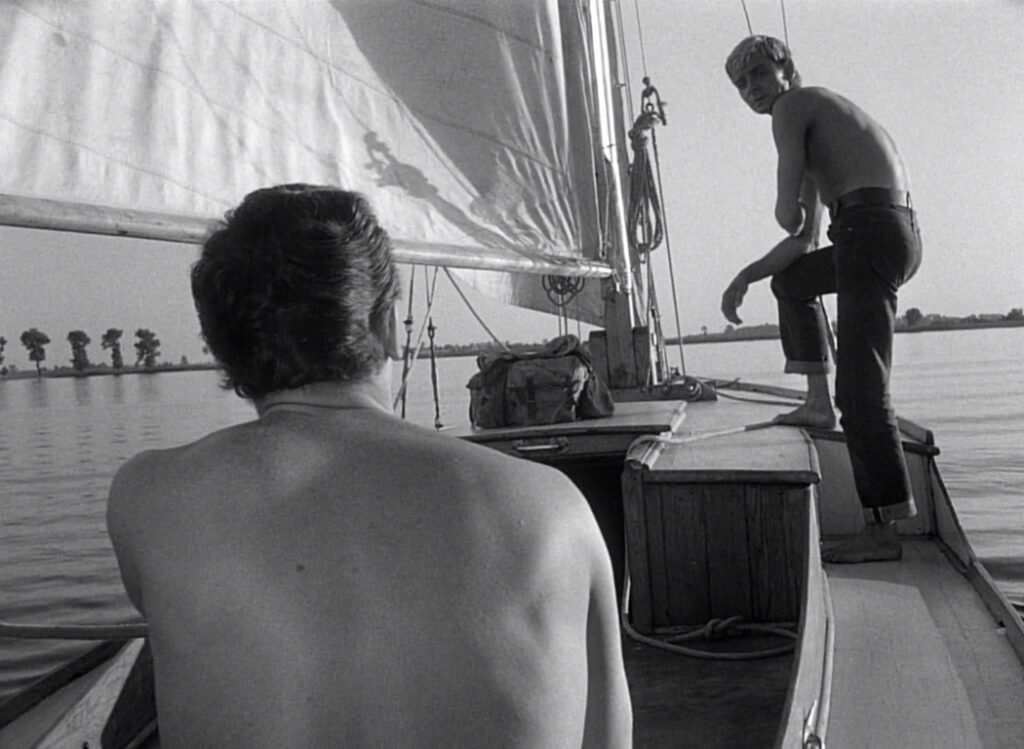
Knife in the Water
1962, directed by Roman Polański
Knife in the Water ends at a road junction where Andrzej must decide whether to report the hitchhiker’s possible drowning to the police, or whether to turn the other way and return directly to his normal life with Krystyna. We’re left to ponder the stakes of his decision ourselves, but it’s not the usual dilemma. Certainly there’s a moral component to his choice, and as rough as Andrzej may be, he’s not insensitive to his responsibility – but the movie is not asking a moral question. Nor will the decision have any practical impact on the couple’s lives. The hitchhiker is alive and well, as Krystyna knows and has told her husband. The impact is entirely internal. Depending which way he goes, Andrzej will see himself differently.
When Krystyna revealed to Andrzej that the hitchhiker had returned to their boat, she also confessed to cheating on her husband with the young man. Andrzej finds her story unbelievable, but he must be aware that his pride weighs heavily in that assessment. If he drives to the police station Krystyna will have to tell the truth, and he’ll find out whether her story is made up. That, however, is a few minutes off. He must decide right now which outcome he fears more: having killed the boy, or having been cuckolded. Either choice has a positive element: go home and trust his wife, or go to the police and report what he did – but surely it’s the negative element that would dominate either decision: to evade the law and be a coward, or to seek certainty and be weak.
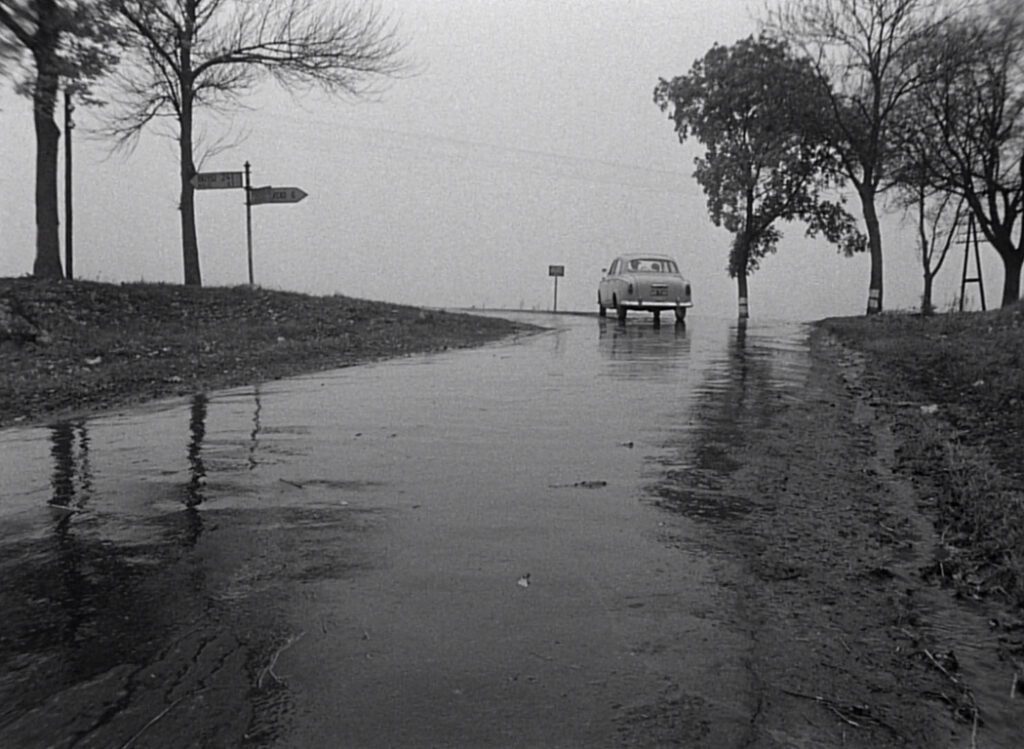
Whichever way he goes will have consequences for Andrzej’s manhood, after his manhood has been so relentlessly tested over the past 24 hours. Ever since the hitchhiker played chicken with him to stop the car, Andrzej’s been in an unending battle of wills with a man half his age. Whether asserting his position as skipper, racing to blow up air mattresses, playing jackstraws, or fighting over the knife, he and the hitchhiker compete with each other continually. Even when the boy stares up at the sky and compares a cloud to a sheep, Andrzej is ready to take it as a personal affront. Because neither of them maintains a consistent upper hand, they continue to test and push each other – Andrzej bosses the young man around and embarrasses him, but the hitchhiker keeps pushing his boundaries: climbing the mast without permission, laughing at Andrzej, and chucking the oar in the water.
There is no shortage of phallic symbols in Knife in the Water – the mast, the oar, the jackstraws, the inflatable crocodile, the pipe, the boat itself – but the most potent phallic symbol is the knife, which hovers over the action like an unspoken threat. When the hitchhiker first pulls it out Krystyna describes it as “murderous”. The two males take turns holding it, each using it in turn to prove his manhood, either at five finger fillet or throwing it like a dart at the chopping board, but ironically it seems to keep peace between the two. Only when it falls into the water – the moment that gives the movie its title – does the simmering conflict come to a head: the men fight, the hitchhiker falls overboard, the couple searches for him, Andrzej leaves, and the young man swims aboard and makes love to Krystyna.
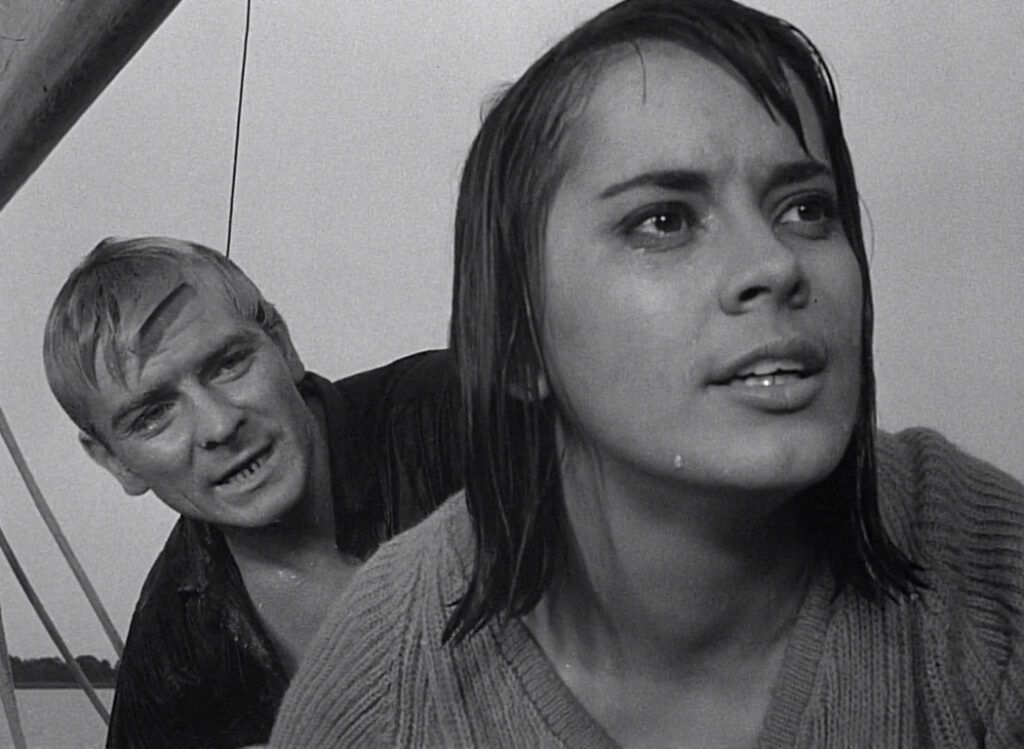
The knife’s role as a symbolic phallus tempts a Lacanian reading, and the age difference between the men hints at an Oedipal triangle. The movie may support these interpretations, but neither of them gives Knife in the Water credit for much more than illustrating a psychoanalytic theory. To locate the movie’s own ideas, its contribution to resolving the dilemmas of masculinity, we must make a couple of observations on its structure.
First of all, Knife in the Water is primarily Andrzej’s story. The arc concerns him above the other two characters. In the opening shot he’s riding in the passenger seat and apparently doesn’t like the way his wife is driving, so she gets out and switches seats. From here on he’ll be the only driver, and he’ll be the skipper on the boat – but by the end we’ll see that taking control has put him at such a disadvantage that he no longer even knows which way to go.
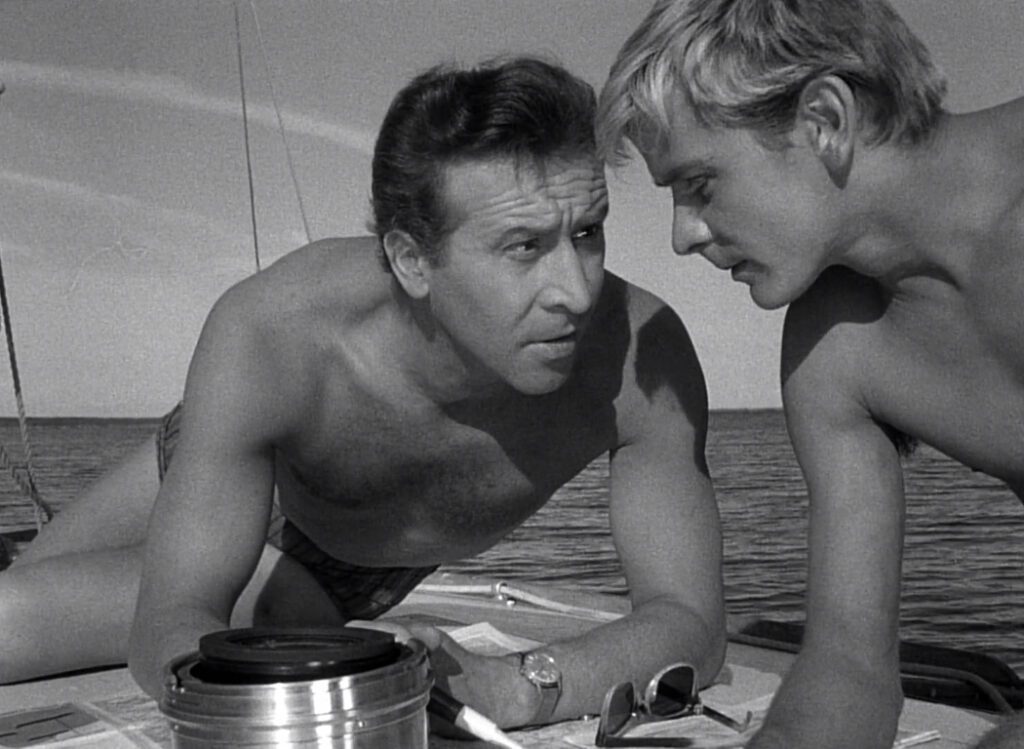
Secondly, the movie takes every opportunity to insinuate that the two males represent the same character at different ages. This would answer why we never hear the hitchhiker’s name. Our biggest clue is what Krystyna says to the boy when they’re alone near the end:
“You’re just like him, only half his age and twice as dumb.”
“What do you know about life? Just cafés, yachts, and cars. Bet you’ve got a four-room apartment.”
“I suppose you live four students to a room.”
“Six, actually.”
“I’ve been through it myself. So has he. You’re no better than him. He was just like you. And you want to be like him. And you will be, if you’ve got the guts.”
Her comments point to an equivalence that we’ve already had many chances to observe, not only in their rivalry but also in the way they actually get along between one-upping each other. The hitchhiker claims to read Andrzej’s mind when he’s invited onto the boat, and he’s already read his mind playing chicken on the road. Andrzej upbraids the boy for whistling, but he soon catches himself doing the same. Both are attracted to – and also attract – the same woman. Additionally, their equivalence could account for the odd handful of Christ allusions around the hitchhiker: walking on water, posing with arms outstretched and a coiled rope for a halo, and the boat’s name “Christine” cut off after “Christ” in a couple shots. There’s not enough material for a religious allegory, but just enough to remind us of the man theology identifies as being one with God the Father.
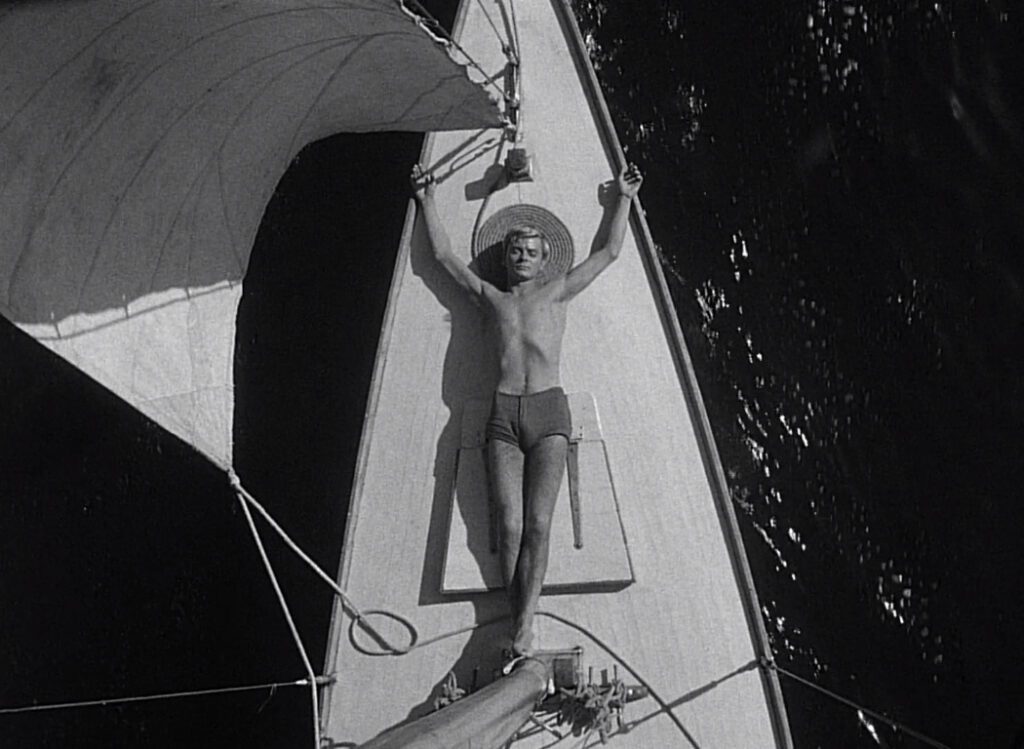
It’s not that we need to take the two men as literally the same person. Their equivalence, rather, tells us they are not merely characters in a plot – each stands for maleness itself at a different stage of life, the younger one in the process of becoming the older one. Once we see Andrzej as a joint character, his arc becomes multi-dimensional, exhibiting change not only across 24 hours but across half his life. The difference between youth and middle age is revealed in the story of a sailor Andrzej once knew, who smashed a pair of bottles and walked on the broken glass to impress his mates. The story is interrupted twice, told in three segments spanning the film, and completing the dialogue at the end. Having shoveled coal in his youth, the sailor had had tough feet and could pull off the trick easily, but in middle age his feet had grown soft and spurted blood all over the glass.
Andrzej himself sums it up at the end: the sailor had become overconfident, and we can see the same quality in Andrzej. The same idea appears in the difference between walking and sailing, which sets the two men apart even before they set sail. As a man gets older, he tends to “sail” through life, coasting on habit, experience, and past accomplishments to make life easier, but he loses the protections granted to the more active life of a young man. The sailor with the broken bottles is no different – as a young man he was so good at walking that he could cross hot coals and broken glass, but he softened with age. The movie’s last line is about this sailor: “No idea what became of him.” Without witnessing Andrzej’s fateful decision, we are left not knowing what becomes of him either. He and the sailor are basically identical.
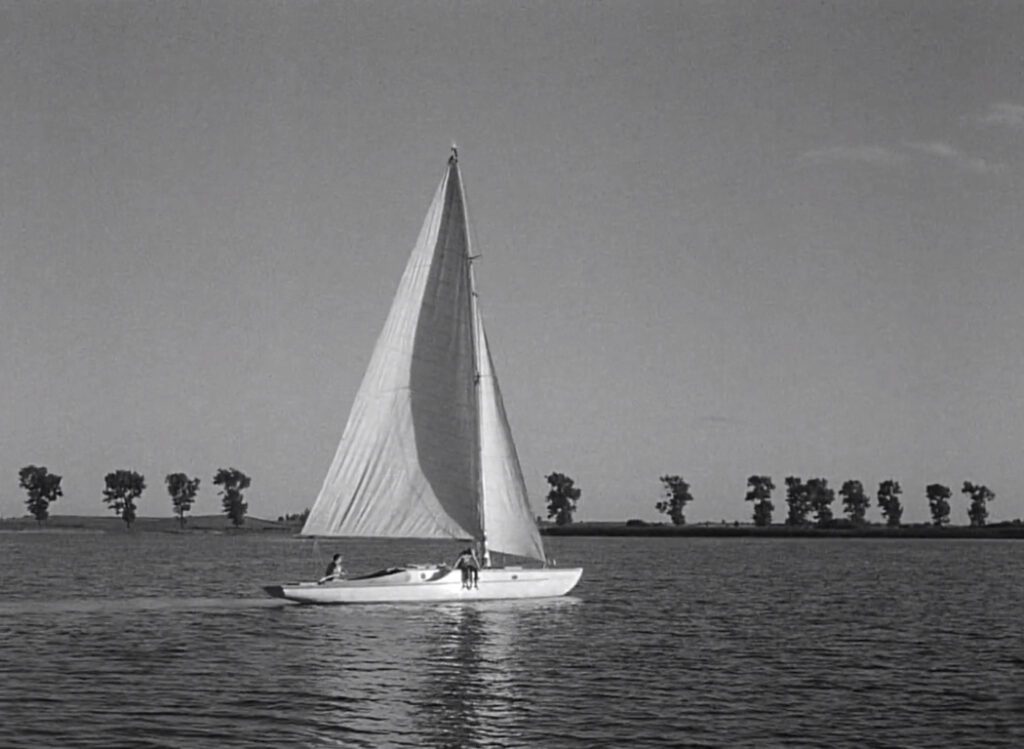
Andrzej is lost at the end, denied any kind of resolution, precisely because of his need for control. If he hadn’t taken the knife, the hitchhiker would have come back ashore with the couple. If he hadn’t fought with Krystyna, telling her she’d be a whore without him, she wouldn’t have cheated on him. His fatal flaw is exposed in the opening minutes when he takes over the car, and the rest of the movie elaborates on the costs and pitfalls of being an alpha male. When Andrzej first asserts control over the hitchhiker, making him coil the rope, the boy asks him what he does for a living, initially guessing he’s a gynecologist, an authority on women… but in fact Andrzej writes for a sports magazine. He’s fascinated by competition, and his life is built around the ideal of control. At the end, whenever he leaves that road junction, he will have to give up part of his own mastery.
CONNECTIONS:
Such a Pretty Little Beach – Two characters representing the same person at different ages
Plein soleil – Two competing men and a woman on a yacht; conflict comes to head with knife
La notte – Love triangle where two persons may be viewed as the same person at different ages
Winter Light – Significance in a man and a woman switching driver’s role
Red Desert – Protagonist tells a story that secretly refers to self in the third person
Chinatown – Male protagonist who imagines himself in control when he is in fact lost
The Passenger – Protagonist tells a story that secretly refers to self in the third person
Dry Season – Story about manhood with a plethora of phallic symbols
Enemy – Two characters who are essentially the same person; commentary on masculinity
There Is No Evil – Ends with a car stopped on a highway, leaving the viewer to guess what happens inside